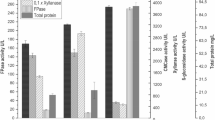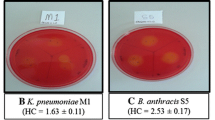Abstract
The biological delignification of lignocellulosic feedstocks, Prosopis juliflora and Lantana camara was carried out with Pycnoporus cinnabarinus, a white rot fungus, at different scales under solid-state fermentation (SSF) and the fungal treated substrates were evaluated for their acid and enzymatic saccharification. The fungal fermentation at 10.0 g substrate level optimally delignified the P. juliflora by 11.89% and L. camara by 8.36%, and enriched their holocellulose content by 3.32 and 4.87%, respectively, after 15 days. The fungal delignification when scaled up from 10.0 g to 75.0, 200.0 and 500.0 g substrate level, the fungus degraded about 7.69–10.08% lignin in P. juliflora and 6.89–7.31% in L. camara, and eventually enhanced the holocellulose content by 2.90–3.97 and 4.25–4.61%, respectively. Furthermore, when the fungal fermented L. camara and P. juliflora was hydrolysed with dilute sulphuric acid, the sugar release was increased by 21.4-42.4% and the phenolics content in hydrolysate was decreased by 18.46 and 19.88%, as compared to the unfermented substrate acid hydrolysis, respectively. The reduction of phenolics in acid hydrolysates of fungal treated substrates decreased the amount of detoxifying material (activated charcoal) by 25.0–33.0% as compared to the amount required to reduce almost the same level of phenolics from unfermented substrate hydrolysates. Moreover, an increment of 21.1–25.1% sugar release was obtained when fungal treated substrates were enzymatically hydrolysed as compared to the hydrolysis of unfermented substrates. This study clearly shows that fungal delignification holds potential in utilizing plant residues for the production of sugars and biofuels.


Similar content being viewed by others
References
Akhtar M, Blanchette RA, Kirk TK (1997) Fungal delignification and biomechanical pulping of wood. Adv Biochem Eng Biotechnol 57:159–195
Alves AMCR, Record E, Lomascolo A, Scholtmeijer K, Asther M, Wessels JGH, Wosten HAB (2004) Highly efficient production of laccase by basidomycete Pycnoporus cinnabarinus. Appl Environ Microbiol 70:6379–6384
Berrocal M, Ball AS, Huerta S, Barrasa JM, Hernández M, Pérez-Leblic MI, Arias ME (2000) Biological upgrading of wheat straw through solid-state fermentation with Streptomyces cyaneus. Appl Microbiol Biotechnol 54:764–771
Bustamente P, Ramos J, Zuñiga V, Sabharwal HS, Young RA (1999) Biomechanical pulping of bagasse with the white rot fungi Ceriporiopsis subvermispora and Pleurotus ostreatus. TAPPI J 82:123–128
Carrillo F, Lis MJ, Colom X, López-Mesas M, Valldeperas J (2005) Effect of alkali pretreatment on cellulase hydrolysis of wheat straw: kinetic study. Proc Biochem 40:3360–3364
Chandel AK, Kapoor RK, Singh A, Kuhad RC (2007) Detoxification of sugarcane bagasse hydrolysate improves ethanol production by Candida shehatae NCIM 3501. Bioresour Technol 98:1947–1950
Dhawan S, Kuhad RC (2003) Ethidium bromide stimulated hyper laccase production from bird’s nest fungus Cyathus bulleri. Lett Appl Microbiol 36(1):1–3
Eggert C, Temp U, Eriksson KEL (1996) The ligninolytic system of the white rot fungi Pycnoporus cinnabarinus: purification and characterization of the laccase. Appl Microbiol Biotechnol 62:1151–1158
Falconiner BC, Lapierre L, Lesage-Meessen G, Yonnet P, Brunerie B, Colonna-Ceccaldi G, Corrieu M, Asther L (1994) Vanillin as a product of ferulic acid biotransformation by the white-rot fungus Pycnoporus cinnabarinus I-937: identification of metabolic pathways. J Biotechnol 37:123–132
Galhaup C, Goller S, Peterbauer CK, Strauss J, Haltrich D (2002) Characterization of the major laccase isoenzyme from Trametes pubescens and regulation of its synthesis by metal ions. Microbiology 148:2159–2169
Gupta R, Sharma KK, Kuhad RC (2009) Separate hydrolysis and fermentation (SHF) of Prosopis juliflora, a woody substrate, for the production of cellulosic ethanol by Saccharomyces cerevisiae and Pichia stipitis NCIM 3498. Bioresour Technol 100:1214–1220
Himmel ME, Ding S-Y, Johnson DK, Adney WS, Nimlos MR, Brady JW, Foust TD (2007) Biomass recalcitrance: engineering plants and enzymes for biofuels production. Science 315:804–807
Keller FA, Hamillton TE, Nguyon QA (2003) Microbial pretreatment of biomass potential for reducing severity of thermo-chemical biomass pretreatment. Appl Biochem Biotechnol 105:27–41
Kuhad RC, Singh A (2007) Lignocellulose biotechnology: future prospects. IK International, New Delhi, India
Kuhad RC, Singh A, Eriksson KEL (1997) Microorganisms and enzymes involved in the degradation of plant fiber cell walls. Adv Biochem Eng 57:45–125
Kuhar S, Nair LM, Kuhad RC (2008) Pretreatment of lignocellulosic material with fungi capable of higher lignin degradation and lower carbohydrate degradation improves substrate acid hydrolysis and the eventual conversion to ethanol. Can J Microbiol 54:305–313
Kumar P, Barrett DM, Delwiche MJ, Stroeve P (2009) Methods for pretreatment of lignocellulosic biomass for efficient hydrolysis and biofuel production. Ind Eng Chem Res 48:3713–3729
Meza JC, Sigoillot JC, Lomascolo A, Navarro D, Auria R (2006) New process for fungal delignification of sugar-cane bagasse and simultaneous production of laccase in a vapor phase bioreactor. J Agric Food Chem 54:3852–3858
Miller GL (1959) Dinitrosalicylic acid reagent for determination of reducing sugars. Anal Chem 31:426–428
Mosier N, Wyman C, Dale B, Elander R, Lee YY, Holtzapple M, Ladisch MR (2005) Features of promising technologies for pretreatment of lignocellulosic biomass. Bioresour Technol 96:673–686
Mussatto SI, Roberto IC (2004) Alternatives for detoxification of diluted-acid lignocellulosic hydrolyzates for use in fermentative processes: a review. Bioresour Technol 93:1–10
Öhgren K, Bengtsson O, Marie F, Grauslund G, Galbe M, Hahn-Hägerdal B, Zacchi G (2006) Simultaneous saccharification and co-fermentation of glucose and xylose in steam-pretreated corn stover at high fiber content with Saccharomyces cerevisiae TMB3400. J Biotechnol 126:488–498
Palmqvist E, Grage H, Meinander NQ, Hahn-Hagerdal B (1999) Main and interaction effects of acetic acid, furfural and p-hydroxybenzoic acid on growth and ethanol productivity of yeasts. Biotechnol Bioeng 63:46–55
Shi J, Chinn MS, Sharma-Shivappa RR (2008) Microbial pretreatment of cotton stalks by solid state cultivation by P. chrysosporium. Bioresour Technol 99:6556–6564
Silverstein RA, Chen Y, Sharma RR, Boyette MD, Osborne J (2007) A comparison of chemical pretreatment methods for improving saccharification of cotton stalks. Bioresour Technol 98:3000–3011
Singleton VL, Orthofer R, Lamuela-Raventos RM (1999) Analysis of total phenols and other oxidation substrates and antioxidiants by means of Folin–Ciocalteu reagent. Method Enzymol 299:152–178
Taniguchi M, Suzuki H, Watanabe D, Sakai K, Hoshino K, Tanaka T (2005) Evaluation of pretreatment with Pleurotus ostreatus for enzymatic hydrolysis of rice straw. J Biosci Bioeng 100:637–643
TAPPI (1992) Technical Association of Pulp and Paper Industry. Atlanta, GA, USA
Teymouri F, Laureano-Perez L, Alizadeh H, Dale BE (2005) Optimization of the ammonia fiber explosion (AFEX) treatment parameters for enzymatic hydrolysis of corn stover. Bioresour Technol 96:2014–2018
Wyman CE (2007) What is (and is not) vital to advancing cellulosic ethanol. Trend Biotechnol 25:153–157
Yu H, Guo G, Zhang X, Yan K, Xu C (2009a) The effect of biological pretreatment with the selective white-rot fungus Echinodontium taxodii on enzymatic hydrolysis of softwoods and hardwoods. Bioresour Technol 100:5170–5175
Yu J, Zhang J, He J, Liu Z, Yu Z (2009b) Combinations of mild physical or chemical pretreatment with biological pretreatment for enzymatic hydrolysis of rice hull. Bioresour Technol 100:903–908
Zhang X, Xu C, Wang H (2007a) Pretreatment of bamboo residues with Coriolus versicolor for enzymatic hydrolysis. J Biosci Bioeng 104:149–151
Zhang X, Yu H, Huang H, Liu Y (2007b) Evaluation of biological pretreatment with white rot fungi for the enzymatic hydrolysis of bamboo culms. Int Biodet Biodeg 60:159–164
Acknowledgments
The authors are thankful to Ms. Urvashi Kuhad, Department of English, University of Delhi for her help during the preparation of manuscript. The financial support from the Department of Biotechnology, Ministry of Science and Technology, New Delhi, India is highly acknowledged.
Author information
Authors and Affiliations
Corresponding author
Rights and permissions
About this article
Cite this article
Gupta, R., Mehta, G., Khasa, Y.P. et al. Fungal delignification of lignocellulosic biomass improves the saccharification of cellulosics. Biodegradation 22, 797–804 (2011). https://doi.org/10.1007/s10532-010-9404-6
Received:
Accepted:
Published:
Issue Date:
DOI: https://doi.org/10.1007/s10532-010-9404-6




